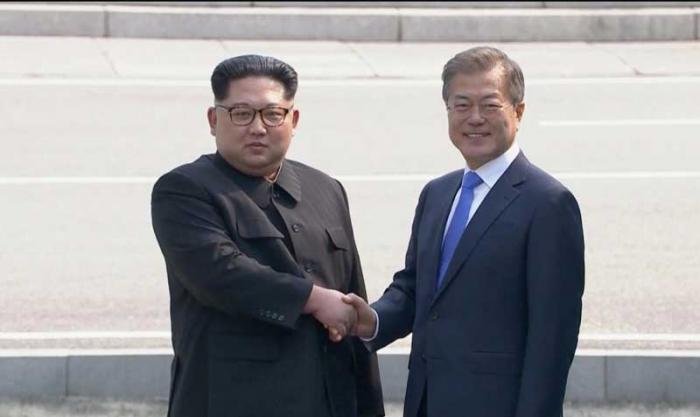Kim and Moon for a Nuclear Free Korea: Too good to be true?

This event is a good beginning which has a face saving option for all parties unless a hard line is adopted by someone. The US and Japan are unlikely to be moved by optics and will be keen in eradication of threat to them, hence may not remove or soften sanctions, which Kim may be eyeing for by such niceties with South Korea. –Maj Gen S B Asthana*
Every event of Korean leaders’ summit on 27 April 2018 has been covered extensively by the media highlighting their pledge to end their six decades of hostility. Airing their rhetoric about commitment to peace and “complete” denuclearization of Korean peninsula and eventually achieve unification, looks too good, but too quick, to be true.
In a scripted ceremony Kim Jong-un did become the first North Korean leader to walk across the demarcation line to South Korea since the Korean War of 1953 vintage. Korean War was halted by an armistice signed in 1953, but did not formally end through any permanent peace agreement. The declaration by the both Koreas to work together for a “nuclear-free Korea”, disarmament, as well as officially ending the war at Panmunjom in 2018 is a historical event, which may outwardly amuse population both sides, but it needs careful decoding.
How and Why the Event happened as per Expected Script?
South Korea was under maximum pressure due to war clouds over its territory because of hard line taken by North Korea and US. Kim’s adventurism with no noticeable control by China and Russia, a war of words and incremental sanctions by US and UN were making things worse in Korean Peninsula. With mountain collapsing at the nuclear site and fear of radiations continues to add to the risk to nearby areas. Under immense pressure South Korea was able to set the stage for Kim –Trump meet, which is possible only if this summit went off well on scripted lines. Under domestic pressure due to hard hitting sanctions, and nuclear test related dangers, Kim was also mentally prepared to follow the peace narrative.
Will this Inter-Korean Peace Initiative Work?
The United States, China and Russia welcomed the agreement as their first response. The criticism indicates that the document promises mutual disarmament “in a phased manner” to build trust, lacks any roadmap/ timelines for implementation. It does not meet US expectation of “complete, verifiable and irreversible” dismantling of North Korea’s nuclear weapons. Any real promise regarding dismantling of missiles and nuclear weapons was missing, and Kim’s image of being nuclear powered dictator has remained intact. Irrespective of skeptics, this summit has set the tone for the Trump –Kim Summit, although some more diplomatic efforts will have to follow.
Beyond the Optics
There are some difficulties, which make some ideas of the Summit impractical. Let me highlight some of them.
- While everyone will like to see the peace and prosperity of Koreans but Neither China nor US will be keen for unified Korea. This will also invite internal opposition in South Korea also. China will not like a democratic unified Korea, balancing between US and China, whereas US will not like its foothold in Korea going away so easily.
- When North Korea threatened US and Japan, the issue expanded beyond bilateral limits of North and South Korea, hence cannot be settled by them bilaterally. Any permanent solution has to be acceptable to US, China, Japan and Russia.
- When Armistice was signed in 1953, US and China representatives were present. The same is a must for lasting peace.
- Expecting Kim to give away the only leverage he has in terms of posing nuclear and missile threat to US, something which has forced President Trump to meet him, sounds unrealistic.
This event is a good beginning which has a face saving option for all parties unless a hard line is adopted by someone. The US and Japan are unlikely to be moved by optics and will be keen in eradication of threat to them, hence may not remove or soften sanctions, which Kim may be eyeing for by such niceties with South Korea.
This article was originally published at Modern Diplomacy EU


















